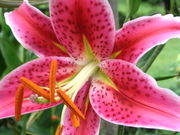 Flower Confidential: The Good, the Bad, and the Beautiful in the Business of Flowers by Amy Stewart
Flower Confidential: The Good, the Bad, and the Beautiful in the Business of Flowers by Amy Stewart
My rating: 4 of 5 stars
Over the weekend I finished reading “Flower Confidential” by Amy Stewart, and what a fascinating read it was! With this book Stewart gives us both the macro and the micro of the industry; in the process she covers botany, genetics, business, marketing, sales, and even addresses the ever present questions of what is our collective fascination with flowers.
 Stewart’s own fascination with flowers comes through in every page. She begins the books with the story of how the “Star Gazer” Lily came to be, explaining not only the breeding aspects, but also providing stories of the lives involved in this development. While explaining how different flower species are cultivated, she discusses the different types of flower farms that can be found in places like California, Colombia, Ecuador, and Holland; in each occasion providing plenty of details not only about the farms’ makeup and management, but also issues relating to pesticide use, labor rights, and land stewardship. In some instances she also traces the development of particular farms, or the growth in popularity of particular flowers.
Stewart’s own fascination with flowers comes through in every page. She begins the books with the story of how the “Star Gazer” Lily came to be, explaining not only the breeding aspects, but also providing stories of the lives involved in this development. While explaining how different flower species are cultivated, she discusses the different types of flower farms that can be found in places like California, Colombia, Ecuador, and Holland; in each occasion providing plenty of details not only about the farms’ makeup and management, but also issues relating to pesticide use, labor rights, and land stewardship. In some instances she also traces the development of particular farms, or the growth in popularity of particular flowers.
On the more technical and detailed side, the author provides an amazing amount of detail about production, and growth; always in an accessible style. For instance, you might have guessed that flower production in a plant ought to be closely linked to light exposure, but did you know that it is actually the night length that regulates flowering? Or for instance that at an upscale florist a rose can fetch around $5 per stem, while the florist paid between $1.50 and $2 per stem, and if you trace this flower back to the grower, most likely in Colombia or Ecuador, this same rose earned the grower $.30. As for the worker who actually cared for this rose all along, each stem sold represents less than $.04 of their wages.
When discussing sales and marketing Stewart discusses how flower production began to take place further and further away from the point of consumption. Modern developments have allowed this to be the case, but decades ago, before we had all this infrastructure certain entrepreneurs began to think it was possible to grow flowers in a variety of countries around the Equator, for consumption in places like the USA, Europe and Russia. As early as 1969 Thomas Keller and David Cheever began to explore countries with ideal flower growing conditions, such as high altitudes, proximity to the equator, predictable weather patterns, and good airports, Colombia, violence and all, was perfect.
 On the business side of things, Stewart discusses both the Latin American flower trade shows as well as the major one in Amsterdam. With sales she also explored the possibilities and complications of producing more environmentally friendly flowers with a product that still has hardly any brand name recognition. She questions how we can start asking for better flowers when once flowers are at the shop, ready for sale, it is nearly impossible to determine where they started out to begin with.
On the business side of things, Stewart discusses both the Latin American flower trade shows as well as the major one in Amsterdam. With sales she also explored the possibilities and complications of producing more environmentally friendly flowers with a product that still has hardly any brand name recognition. She questions how we can start asking for better flowers when once flowers are at the shop, ready for sale, it is nearly impossible to determine where they started out to begin with.
One of the things that I do think it a big gap in the book is the absence of a discussion of women in the flower industry. Stewart briefly mentioned that both in the USA and in countries around the world, women workers have complained about sexual harassment and exploitation while working at flower farms. Still, the author missed a great opportunity to further explore the situation, and the interesting relationship between an industry that in many ways caters to women, but which also has traditionally employed women in exploitative situations (I’m not arguing that this happens on every farms, but it happens much too often anyway). Still, Stewart does address the complicated issues around flower and labor. She discusses how for countries like Colombia and Ecuador, flower production has a bright and dark side. For years now the USA has promoted flower production in a number of Latin American countries as a replacement crop for illegal ones, the incentive being low or no tariffs as they come into the USA market. Flower production is taking over vast amounts of land and in many occasions pushing peasants off the land and into the city where conditions are often worst. Still, when Stewart asked a grower about this situation he pointed out that things are just as complicated when buying USA grown flowers, since in this case you are likely supporting not an “American” worker, but are instead supporting a Mexican, or other Latin American workers who has likely been separated from their family.
Overall it is a fantastic read if you already know something about the flower industry and what to learn more about the details, or if you occasionally buy flowers and had never thought about what flowers go through before they reach you. Stewart will fill you in with all the details in an intelligent, and straight forward manner.
Amy Stewart also has a great website, including an interesting blog.
Norma Galvan
This was really interesting, I am actually considering buying the actual book, but I was able to get some valuable information, of which I will use and properly cite in my senior project research paper. 🙂